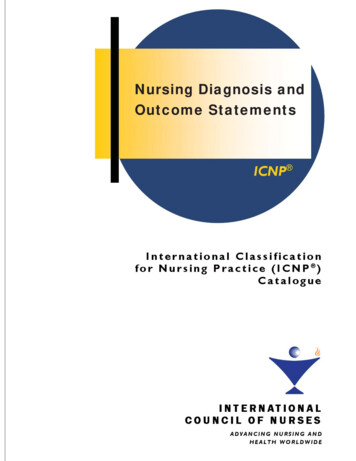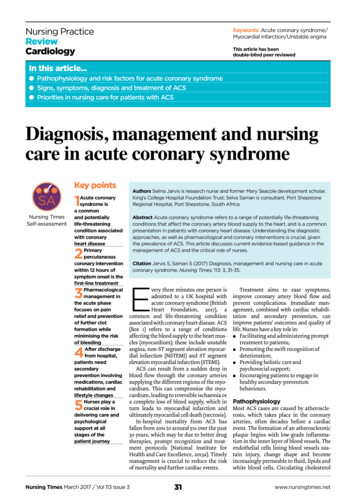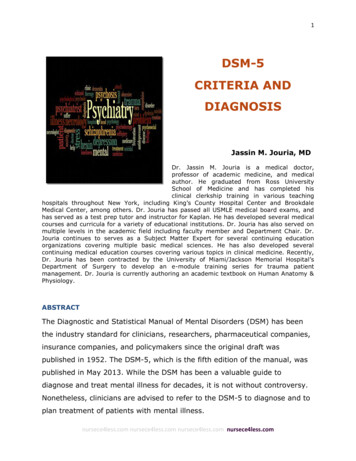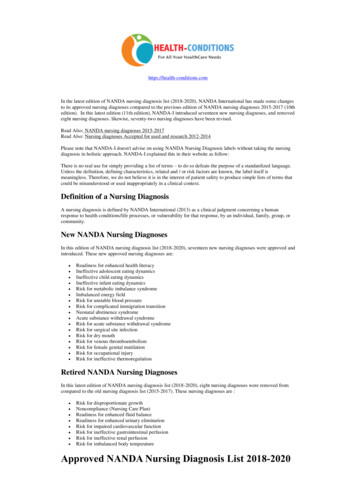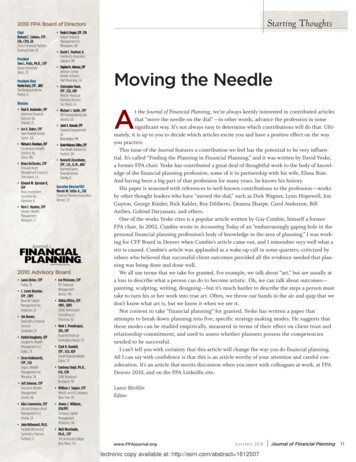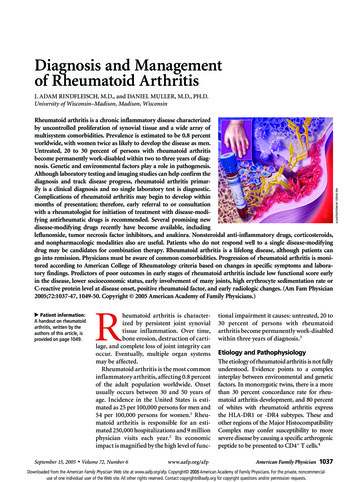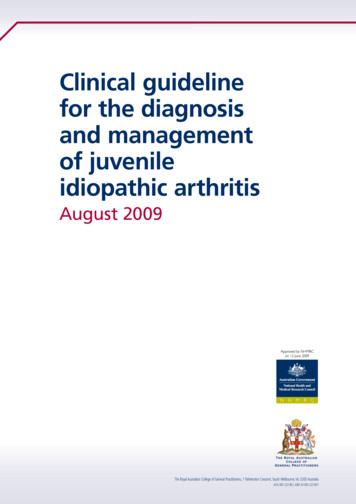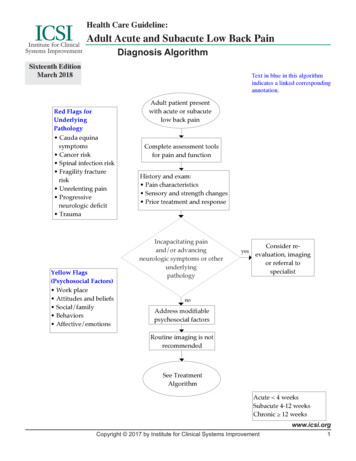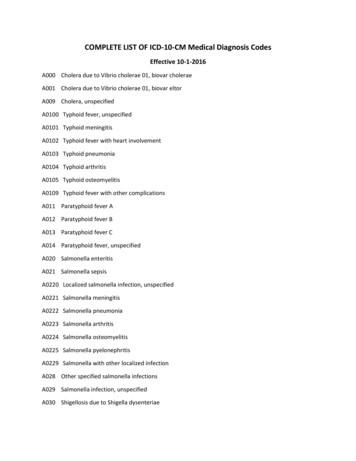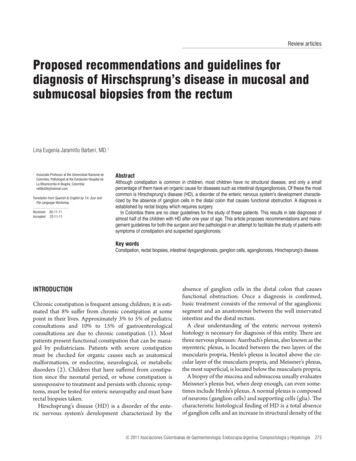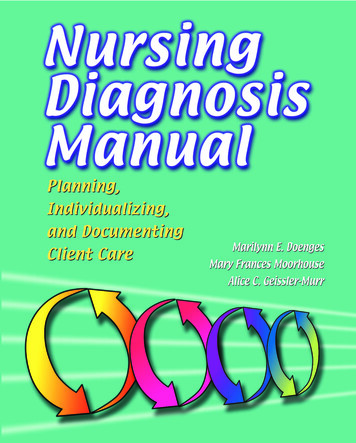
Transcription
Gordon’s FunctionalHealth Patterns IndexACTIVITY-EXERCISE PATTERNactivity intolerance, risk for, 47–49activity intolerance [specify level], 43–47airway clearance, ineffective, 53–58autonomic dysreflexia, 82–85autonomic dysreflexia, risk for, 85–88bed mobility, impaired, 372–75breathing pattern, ineffective, 111–16cardiac output, decreased, 116–22development, risk for delayed, 205–8disuse syndrome, risk for, 214–20diversional activity, deficient, 220–23fatigue, 251–56infant behavior, disorganized, 330–36infant behavior, readiness for enhancedorganized, 337–39infant behavior, risk for disorganized,336–37intercranial adaptive capacity, decreased,354–58peripheral neurovascular dysfunction,risk for, 437–41physical mobility, impaired, 375–80surgical recovery, delayed, 580–83tissue perfusion, ineffective [specifytype], 617–25transfer ability, impaired, 625–28ventilation, impaired spontaneous,665–70ventilatory weaning response,dysfunctional, 671–75walking, impaired, 683–86wandering [specify sporadic orcontinual], 686–90wheelchair mobility, impaired, 380–83COGNITIVE-PERCEPTUALPATTERNconfusion, acute, 150–54confusion, chronic, 154–58decisional conflict [specify], 142–46environmental interpretation syndrome,impaired, 227–31knowledge, deficient [learning need](specify), 358–63knowledge, readiness for enhanced[specify], 363–65memory, impaired, 368–71pain, acute, 417–22pain, chronic, 422–28sensory perception, disturbed [specifytype], 510–17thought processes, disturbed, 607–11COPING-STRESS TOLERANCEPATTERNadjustment, impaired, 49–52coping, community: ineffective, 184–87coping, community: readiness forenhanced, 190–92coping, family: compromised, 169–75coping, family: disabled, 175–79coping, family: readiness for enhanced,192–95coping, ineffective, 179–84coping, ineffective community, 184–86coping, readiness for enhanced, 187–89post-trauma syndrome, risk for, 453–57post-trauma syndrome [specify stage],447–53self-mutilation, 503–6self-mutilation, risk for, 506–10suicide, risk for, 575–80ELIMINATION PATTERNbowel incontinence, 96–99constipation, 158–63constipation, risk for, 166–69diarrhea, 209–14urinary elimination, impaired, 633–38urinary incontinence, functional, 640–43urinary incontinence, reflex, 643–46urinary incontinence, stress, 646–50urinary incontinence, total, 650–54urinary retention, acute/chronic,660–65urinary urge incontinence, 657–60urinary urge incontinence, risk for,654–57HEALTH PERCEPTION-HEALTHMANAGEMENT PATTERNenergy field, disturbed, 224–27falls, risk for, 235–39health maintenance, ineffective, 305–8health-seeking behaviors, 308–11infection, risk for, 342–46injury, risk for, 346–50noncompliance [specify], 391–95perioperative positioning injury, risk for,351–54poisoning, risk for, 441–46protection, ineffective, 465–66sudden infant death syndrome, risk for,195–98suffocation, risk for, 571–75therapeutic regimen: community,ineffective management, 592–95therapeutic regimen: effectivemanagement, 589–92therapeutic regimen: family, ineffectivemanagement, 595–98therapeutic regimen: ineffectivemanagement, 598–601therapeutic regimen: readiness forenhanced management, 601–4NUTRITIONAL-METABOLICPATTERNallergy response: latex, 58–62allergy response: latex, risk for, 62–64
NUTRITIONAL-METABOLICPATTERN (continued)body temperature, risk for imbalanced,93–96breast feeding, interrupted, 108–11breastfeeding, effective [learning need],100–103breastfeeding, ineffective, 103–8dentition, impaired, 201–5failure to thrive, adult, 232–35fluid balance, readiness for enhanced,260–63fluid volume, excess, 272–76fluid volume, risk for deficient, 276–79hyperthermia, 319–23hypothermia, 323–27infant feeding pattern, ineffective,340–42nausea, 383–87nutrition: imbalanced, less than bodyrequirements, 395–401nutrition: imbalanced, more than bodyrequirements, 401–6nutrition: imbalanced, risk for more thanbody requirements, 406–9nutrition, readiness for enhanced,409–12oral mucous membrane, impaired,412–17skin integrity, impaired, 525–31skin integrity, risk for impaired,531–35swallowing, impaired, 583–89ROLE-RELATIONSHIP PATTERNattachment, risk for impairedparent/child/infant, 78–82caregiver role strain, 123–28caregiver role strain, risk for, 129–32communication, readiness for enhanced,138–42family processes, dysfunctional, 244–48family processes, dysfunctional:alcoholism, 240–44family processes, readiness for enhanced,248–51grieving, anticipatory, 287–91grieving, dysfunctional, 291–95parental role conflict, 146–49parenting, impaired, 428–33parenting, impaired, risk for, 433–34parenting, readiness for enhanced,434–37relocation stress syndrome, risk for,477–79social interaction, impaired, 548–53social isolation, 553–57verbal communication, impaired,132–38violence, risk for other-directed, 675–83SELF-PERCEPTION–SELFCONCEPT PATTERNanxiety [mild, moderate, severe, panic],64–70anxiety, death, 70–74body image, disturbed, 88–93fear [specify focus], 256–60hopelessness, 315–19loneliness, risk for, 365–68personal identity, disturbed, 327–30powerlessness, risk for, 462–65powerlessness [specify level], 457–62self-concept, readiness for enhanced,490–92self-esteem, risk for situational low,497–99self-esteem, situational low, 499–503SEXUALITY-REPRODUCTIVEPATTERNrape-trauma syndrome [specify],467–72sexual dysfunction, 517–21sexuality patterns, ineffective, 522–25SLEEP-REST PATTERNsleep, readiness for enhanced, 535–38sleep pattern, disturbed, 543–48VALUE-BELIEF PATTERNspiritual distress, 561–65spiritual distress, risk for, 565–68spiritual well-being, readiness forenhanced, 568–71
NURSING DIAGNOSIS MANUAL:Planning, Individualizing,and Documenting Client Care
NURSING DIAGNOSIS MANUAL:Planning, Individualizing,and Documenting Client CareM A R I LY N N E . D O E N G E S ,RN, BSN, MA, CSClinical Specialist, Adult Psychiatric/Mental Health Nursing, RetiredAdjunct Faculty, Beth-El College of Nursing and Health Sciences, CU-SpringsColorado Springs, ColoradoM A RY F R A N C E S M O O R H O U S E ,RN, BSN, CRRN, LNCNurse ConsultantTNT-RN Enterprises, Adjunct Nursing Faculty, Pikes Peak Community CollegeColorado Springs, ColoradoA L I C E C .M U R R ,RN, BSN, LNCLegal Nurse ConsultantTelephone Triage NurseColorado Springs, ColoradoF.A. DAVIS COMPANY Philadelphia
F. A. Davis Company1915 Arch StreetPhiladelphia, PA 19103www.fadavis.comCopyright 2005 by F. A. Davis CompanyCopyright 2005 by F. A. Davis Company. All rights reserved. This book is protected by copyright. No part of it may bereproduced, stored in a retrieval system, or transmitted in any form or by any means, electronic, mechanical, photocopying,recording, or otherwise, without written permission from the publisher.Printed in the United States of AmericaLast digit indicates print number: 10 9 8 7 6 5 4 3 2 1Publisher, Nursing: Robert G. MartoneDesign Manager: Joan WendtDevelopmental Editor: Alan SorkowitzProject Editor: Danielle J. BarskyAs new scientific information becomes available through basic and clinical research, recommended treatments and drug therapies undergo changes. The author(s) and publisher have done everything possible to make this book accurate, up to date, andin accord with accepted standards at the time of publication. The author(s), editors, and publisher are not responsible forerrors or omissions or for consequences from application of the book, and make no warranty, expressed or implied, in regardto the contents of the book. Any practice described in this book should be applied by the reader in accordance with professional standards of care used in regard to the unique circumstances that may apply in each situation. The reader is advisedalways to check product information (package inserts) for changes and new information regarding dose and contraindicationsbefore administering any drug. Caution is especially urged when using new or infrequently ordered drugs.Library of Congress Cataloging-in-Publication DataDoenges, Marilynn E., 1922Nursing diagnosis manual : planning, individualizing, and documenting client care / Marilynn E. Doenges, Mary FrancesMoorhouse, Alice C. Geissler-Murr.p. ; cm.Includes bibliographical references and index.ISBN 0-8036-1156-0 (softcover : alk. paper)1. Nursing diagnosis—Handbooks, manuals, etc. 2. Nursing assessment—Handbooks, manuals, etc. 3. Nursing—Planning—Handbooks, manuals, etc.[DNLM: 1. Nursing Diagnosis. 2. Nursing Records. 3. Patient Care Planning. WY 100.4 D649n 2005] I. Moorhouse,Mary Frances, 1947- II. Geissler-Murr, Alice, 1946- III. Title.RT48.6.D643 2005610.73—dc222004014155Authorization to photocopy items for internal or personal use, or the internal or personal use of specific clients, is granted byF. A. Davis Company for users registered with the Copyright Clearance Center (CCC) Transactional Reporting Service,provided that the fee of .10 per copy is paid directly to CCC, 222 Rosewood Drive, Danvers, MA 01923. For those organizations that have been granted a photocopy license by CCC, a separate system of payment has been arranged. The fee codefor users of the Transactional Reporting Service is: 8036-1156-0/05 0 ! .10.
To our spouses, children, parents, and friends, who much of the time have had to manage without us while wework and dream as well as cope with our struggles and frustrations.The Doenges families: the late Dean, Jim; Barbara and Bob Lanza; David, Monita, Matthew and Tish,Tyler; John,Holly, Nicole, and Kelsey; and the Daigle family, Nancy, Jim, Jennifer, Brandon and Annabelle Smith-Daigle, andJonathan and Kim.The Moorhouse family: Jan; Paul; Jason, Alexa, and Mary Isabella.To my large, extended family:Thank you all for having patience and giving me help and time. I love each oneof you. AliceTo our FAD family, especially Bob Martone; and to Alan Sorkowitz, whose support, “acupressure,” and encouragement were so vital to the completion of a project of this magnitude.To the nurses we are writing for, who daily face the challenge of caring for the acutely ill patient and are looking for a practical way to organize and document this care. We believe that nursing diagnosis and these guideswill help.And to NANDA and the International nurses who are developing and using nursing diagnoses—we continueto champion your efforts and the work of promoting standardized languages.
PrefaceThe American Nurses Association (ANA)Social Policy Statement of 1980 was the firstto define nursing as the diagnosis and treatment of human responses to actual and potentialhealth problems. This definition, when combinedwith the ANA Standards of Practice, has providedimpetus and support for the use of nursing diagnosis.Defining nursing and its effect on client care supportsthe growing awareness that nursing care is a key factorin client survival and in the maintenance, rehabilitative, and preventive aspects of healthcare. Changesand new developments in healthcare delivery in thelast decade have given rise to the need for a commonframework of communication to ensure continuity ofcare for the client moving between multiple healthcare settings and providers.This book is designed to aid the student nurseand the practitioner in identifying interventionscommonly associated with specific nursing diagnosesas proposed by NANDA International (formerly theNorth American Nursing Diagnosis Association).These interventions are the activities needed toimplement and document care provided to the individual client and can be used in varied settings fromacute to community/home care.Chapter 1 presents a brief discussion of the nursing process and introduces the concept of evidencebased practice. Standardized nursing languages(SNLs) are discussed in Chapter 2, with a focus onNANDA (nursing diagnoses), NIC (interventions),and NOC (outcomes). NANDA has 167 diagnosislabels with definitions, defining characteristics, andrelated or risk factors used to define a client need orproblem. NIC is a comprehensive standardizedlanguage providing 514 direct and indirect interven-tion labels with definitions and a list of activities anurse might choose to carry out each intervention.NOC language provides 330 outcome labels withdefinitions, a set of indicators describing a specificclient, caregiver, family, or community states relatedto the outcome, and a 5-point Likert-type measurement scale that can demonstrate client progress evenwhen outcomes are not fully met. Chapter 3 addressesthe assessment process using a nursing framework fordata collection such as the Diagnostic DivisionsAssessment Tool.A creative approach for developing and documenting the planning of care is demonstrated inChapter 4. Mind Mapping is a new technique orlearning tool provided to assist you in achieving aholistic view of your client, enhancing your criticalthinking skills, and facilitating the creative processof planning client care. For more in-depth information and inclusive plans of care related to specific medical/psychiatric conditions (with rationalesand the application of the diagnoses), the nurse isreferred to the larger works, all published by theF. A. Davis Company: Nursing Care Plans: Guidelines for Individualizing Patient Care, ed 6 (Doenges,Moorhouse, & Geissler-Murr, 2002); PsychiatricCare Plans: Guidelines for Individualizing Care, ed 3(Doenges, Townsend, & Moorhouse, 1998); andMaternal/Newborn Plans of Care: Guidelines forIndividualizing Care, ed 3 (Doenges & Moorhouse,1999).Chapter 6 contains over 800 disorders/healthconditions reflecting all specialty areas, with associated nursing diagnoses written as client problem/need statements to aid you in validating the assessment and diagnosis steps of the nursing process.vii
In Chapter 5, the heart of the book, all the nursingdiagnoses are listed alphabetically for ease of referenceand include the diagnoses accepted for use byNANDA through 2004. The alphabetization of diagnoses follows NANDA’s own sequencing, wherebydiagnoses are alphabetized first by their key term,which is capitalized. Subordinate terminology ordescriptors of the diagnosis are
verbal communication, impaired, 132–38 violence, risk for other-directed, 675–83 SELF-PERCEPTION–SELF-CONCEPT PATTERN anxiety [mild, moderate, severe, panic], 64–70 anxiety, death, 70–74 body image, disturbed, 88–93 fear [specify focus], 256–60 hopelessness, 315–19 loneliness, risk for, 365–68 personal identity, disturbed, 327–30 powerlessness, risk for, 462–65 .
